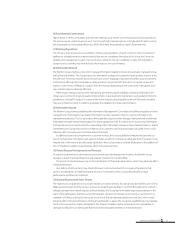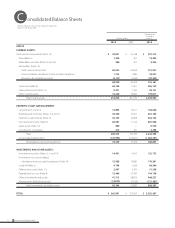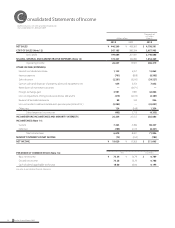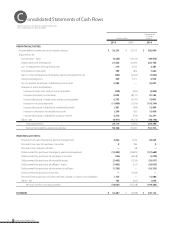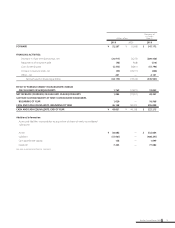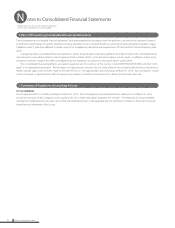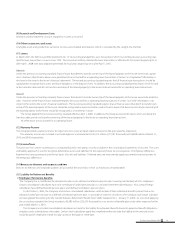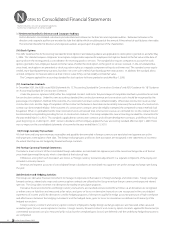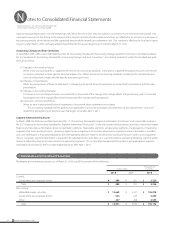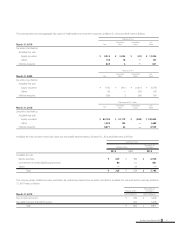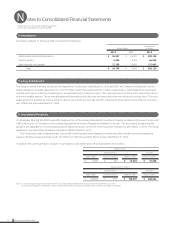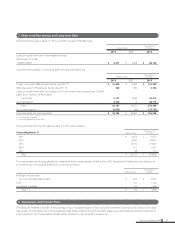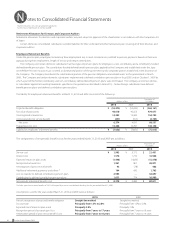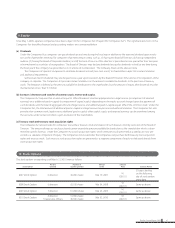Brother International 2010 Annual Report Download - page 24
Download and view the complete annual report
Please find page 24 of the 2010 Brother International annual report below. You can navigate through the pages in the report by either clicking on the pages listed below, or by using the keyword search tool below to find specific information within the annual report.
Notes to Consolidated Financial Statements
Brother Industries, Ltd. and Consolidated Subsidiaries
For the Years ended March 31, 2010 and 2009
(2) Investments in Unconsolidated Subsidiaries and Associated Companies
Investments in 2 unconsolidated subsidiaries (2 in 2009) and 6 associated companies (6 in 2009) are accounted for by the equity method.
Investments in the remaining unconsolidated subsidiaries and associated companies are stated at cost. If these companies had been consoli-
dated or accounted for by the equity method, the effect on the consolidated financial statements would not have been material.
Accordingly, income from the unconsolidated subsidiaries and associated companies is recognized when the Group receives dividends. Unre-
alized inter-company profits, if any, have not been eliminated in the consolidated financial statements.
(3) Unification of Accounting Policies Applied to Foreign Subsidiaries for the Consolidated Financial Statements
On May 17, 2006, the Accounting Standards Board of Japan (the “ASBJ”) issued ASBJ Practical Issues Task Force (PITF) No. 18, “Practical Solution on
Unification of Accounting Policies Applied to Foreign Subsidiaries for the Consolidated Financial Statements.” The new task force prescribes: (1) the
accounting policies and procedures applied to a parent company and its subsidiaries for similar transactions and events under similar circum-
stances should in principle be unified for the preparation of the consolidated financial statements, (2) financial statements prepared by foreign
subsidiaries in accordance with either International Financial Reporting Standards or the generally accepted accounting principles in the United
States tentatively may be used for the consolidation process, (3) however, the following items should be adjusted in the consolidation process so
that net income is accounted for in accordance with Japanese GAAP unless they are not material: 1) amortization of goodwill; 2) scheduled amor-
tization of actuarial gain or loss of pensions that has been directly recorded in the equity; 3) expensing capitalized development costs of R&D; 4)
cancellation of the fair value model of accounting for property, plant, and equipment and investment properties and incorporation of the cost
model of accounting; 5) recording the prior years' effects of changes in accounting policies in the income statement where retrospective adjust-
ments to financial statements have been incorporated; and 6) exclusion of minority interests from net income, if included.
PITF No. 18 was effective for fiscal years beginning on or after April 1, 2008 with early adoption permitted.
The Group applied this accounting standard effective April 2008. The effect of the adoption was not material.
(4) Cash Equivalents
Cash equivalents are short-term investments that are readily convertible into cash and that are exposed to insignificant risk of changes in value.
Cash equivalents include time deposits, certificate of deposits, and investment trust, all of which mature or become due within three months
of the date of acquisition.
(5) Inventories
Inventories are stated at the lower of cost or market. Cost is determined by the average method by the Company and consolidated manufactur-
ing subsidiaries. The consolidated sales subsidiaries determine cost by using the average method or the first-in, first-out method.
(6) Marketable and Investment Securities
Marketable and investment securities are classified and accounted for, depending on management’s intent, as follows:
i ) trading securities, which are held for the purpose of earning capital gains in the near term, are reported at fair value, and the related unrealized
gains and losses are included in earnings,
ii ) held-to-maturity debt securities, which management has the positive intent and ability to hold to maturity, are reported at amortized cost, and
iii) available-for-sale securities with market values, which are not classified as either of the aforementioned securities, are reported at fair value, with
unrealized gains and losses, net of applicable taxes, reported as a separate component of equity. Non-marketable available-for-sale securities
are stated at cost determined by the moving average method.
For other than temporary declines in fair value, marketable and investment securities are reduced to net realizable value by a charge to income.
(7) Property, Plant and Equipment
Property, plant and equipment are stated at cost. Depreciation is mainly computed by the declining-balance method.
The range of useful lives was principally from 3 to 50 years for buildings and structures, from 4 to 12 years for machinery and vehicles and from
2 to 20 years for furniture and fixtures.
Depreciation of leased assets under finance leases is computed by the straight-line method over the lease period.
(8) Long-lived Assets
The Group reviews their long-lived assets for impairment whenever events or changes in circumstance indicate the carrying amount of an asset or
asset group may not be recoverable. An impairment loss would be recognized if the carrying amount of an asset or asset group exceeds the sum
of the undiscounted future cash flows expected to result from the continued use and eventual disposition of the asset or asset group. The impair-
ment loss would be measured as the amount by which the carrying amount of the asset exceeds its recoverable amount, which is the higher of
the discounted cash flows from the continued use and eventual disposition of the asset or the net selling price at disposition.
22 Brother Annual Report 2010



